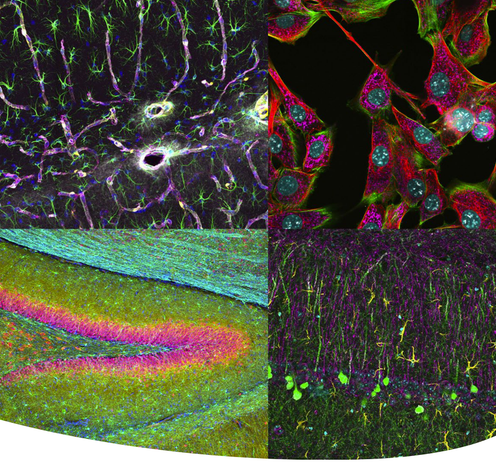Slide scanner
VS200
The Power to See More
Achieve More in Less Time
- Loader holds up to 35 sample trays with a maximum capacity of 210 slides (26 × 76 mm)
- Robotics quickly and safely loads and unloads trays while coordinating with the focus and scan unit for fast acquisition
- Integrated barcode reader automatically captures and records slide information
Loading of slides
- Slides are loaded onto trays before scanning
- Supports 1“x 3“, 2“x 3“, 3“x 4“ and 4“x 5“ slide formats
- Up to 35 trays can be scanned in one batch Max 210 slides.
- Scanning of different slide sizes in the same batch experiment
- Automatic tray type detection by RFID and slide glass detection by proximity sensors
- *Hot swap and priority scan possible
Reliable Data for Many Applications
The flexibility of five imaging modes and outstanding Olympus X Line objectives make the VS200 slide scanner a solution for many applications.
Brain Research
Cortico-thalamic projection pathways labeled with AAV-GFP and AAVtdTomato.
Image data courtesy ofHong Wei Dong, MD, PhD, Professor of Neurology, Keck School of Medicine of University of Southern California.
Drug Discovery
Pancreas stained with Dapi, GFP and RFP.
Image data courtesy ofWenjin Chen,NJ Rutgers Cancer Center.
Cancer and Stem Cell Research
Tonsil CD3 (rm), ImmPRESS Reagent (HRP) Anti-Mouse IgG Immpact DAB (brown), AE1/AE3(m) ImmPRESS (AP) (HRP) Anti-Rabbit IgG Immpact Vector Red (red). Counterstained with Hematoxylin QS (blue).
Image data courtesy of Vector Labs.
Multiplex Scan Mode
When tissue samples are limited, it’s important to get the most possible data from each tissue section. Multiplexing mode aligns multiple fluorescence channels with a reference image, enabling greater understanding of co-expression and spatial composition of multiple targets within a sample.
Lung tissueimaged on a VS200 at 20X stained with an Ultivue PD-L1 kit multiplex kit; Dapi: Nuclear Counterstain, FITC: CD8, TRITC: CD68, Cy5: PD-L1, Cy7: panCK.
Image data courtesy of Ultivue Inc.
High-Contrast Optical Sectioning Images
The SILA (Speckle Illumination Acquisition) optical sectioning device easily integrates into your VS200 system and software.
Speckles are used to obtain high-contrast images, removing out-of-focus light to deliver sharp images, especially from thick samples.
The image is computed during the scan, and there’s no need for post-processing, so the device has a minimal impact on acquisition speed.
Widefield (left) and SILA (right) images of a whole planarian flatworm Schmidtea mediterranea in 20x, showing the intestines. Blue: DAPI. Green: inner intestine cells; Red: outer intestine cells. Samples provided by Amrutha Palavalli, Department for Tissue Dynamics and Regeneration, Max Planck Institute for Multidisciplinary Sciences, Goettingen, Germany.
The SILA module
- Removes out-of-focus light to deliver sharp, high-contrast images
- Combined hardware and software solution
- Generates sectioned images on-the-fly
- Degree of sectioning adjustable using a single parameter – similar to confocal pinhole aperture
- Able to image large areas and thick samples in a relatively short time
- Requires minimal calibration and no objective restrictions
SILA image of a 40um mouse brain sagittal section. Overview acquired at 4x, detailed scan is an extended focal image (EFI) of a 19um Z series acquired at 20x . Blue: DAPI, Green: GFAP (astrocytes), Yellow: IbaI (microglia). Red: NeuN (neurons). Samples provided by Institute of Experimental Neuroregeneration, Spinal Cord Injury and Tissue Regeneration Center Salzburg (SCI-TReCS), Paracelsus Medical University, Austria.
Near-Infrared Imaging Solutions
Near-Infrared Imaging Solutions
See in red—open a spectrum of possibilities. When investigating cellular
processes in the context of their 3D environments, model organisms and
organoids are often superior to 2D culture systems. Near-infrared (NIR)
microscopy has proven beneficial for imaging biological tissues due to a
lower absorption and scattering of NIR light than visible light.
Excellent Optics: The X Line objectives
- Outstanding flatness and higher NA
- The UPLXAPO20X, NA 0.80 comes standard with the system
- Better quality in each image and more efficient acquisition of tiled images
Excellent Optics: Silicon immersion
- Available magnifications: 40x, 60x and 100x
- Ideal for thick brain sections
- Silicone immersion objectives are brighter than comparable oil immersion objectives at sample depths > 6µm
- Silicone immersion oil has almost no evaporation.














